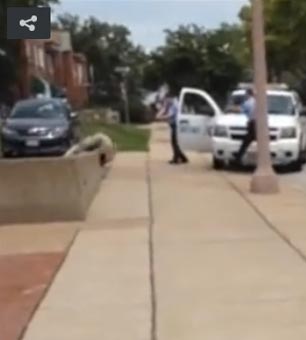It is disappointing to see that there has not been more public outrage – especially in the major media – about the killing of Kajieme Powell. He was shot by St. Louis police on Tuesday just a few miles from where Michael Brown was gunned down. A very clear video of the entire incident was released yesterday, and as the Huffington Post accurately reported, it shows a very different story than the one told by St. Louis Police Chief Sam Dotson the day before.
The video shows that the police pulled up over the curb, just a few yards from where Powell was standing and immediately drew their guns as they jumped out of the van. Within 15 seconds of their van arriving, they were shooting him.
The first three shots sent him falling to the ground. Was it necessary to pump 6 more bullets into him, most of them when he was sprawled on the pavement, to make sure that he would die? This is a question that should be formally investigated. Then they tried to handcuff him though he was practically dead already.
The police will not be charged with a crime, since Powell allegedly had a knife, and they claim to have recovered one from the scene. (No knife is visible in the video – contradicting Dotson’s story that he was charging at the police holding a knife overhead. There are conflicting reports from witnesses about what kind of knife he may have had, with some witnesses saying it was a butter knife). Assuming he had a knife, and since he moved toward the police before they shot him, they claim self-defense.
While such a claim may hold up technically, in the real world, there are a number of ways they could have tried to avoid this killing. This 25-year-old African-American man was reportedly mentally disturbed and was not putting anyone’s life in imminent danger when the police arrived. The video shows that bystanders, including the person who filmed the incident and a couple of passersby, did not indicate any fear of Powell. He was apparently known in the neighborhood.
But the police pulled up and drew their guns on him as if they were in the middle of the Sandy Hook school shooting and children were about to be killed. This immediately set up a confrontation that, given the man’s mental condition (apparently known to these officers), had a high probability of ending in his death.
There are a number of ways that they could have tried to avoid this outcome. One would have been to pull up to Powell with the van locked and maybe roll down the window a bit and talk to Powell without threatening to shoot him. In this situation, he would not have been able to hurt them with a knife, and they knew that he did not have a gun. Since there was no one in imminent danger, they could have taken some time to assess the situation. They could have called for backup if necessary, and used nonlethal force such as a Taser if needed.
These officers showed a reckless and callous disregard for human life, especially by shooting Powell so many times after he was already rendered helpless by the first three bullets. Unfortunately this is not an isolated incident, as many who have protested the police killing of Michael Brown have pointed out and documented. These unjustified police killings and other violence, especially in African-American and poor communities, will continue so long as police are not held accountable.
*An earlier version of this article stated that according to people in the neighborhood, Powell was distraught after attending his mother’s funeral; while people did report that, it was not true.
We’re resisting Trump’s authoritarian pressure.
As the Trump administration moves a mile-a-minute to implement right-wing policies and sow confusion, reliable news is an absolute must.
Truthout is working diligently to combat the fear and chaos that pervades the political moment. We’re requesting your support at this moment because we need it – your monthly gift allows us to publish uncensored, nonprofit news that speaks with clarity and truth in a moment when confusion and misinformation are rampant. As well, we’re looking with hope at the material action community activists are taking. We’re uplifting mutual aid projects, the life-sustaining work of immigrant and labor organizers, and other shows of solidarity that resist the authoritarian pressure of the Trump administration.
As we work to dispel the atmosphere of political despair, we ask that you contribute to our journalism. Over 80 percent of Truthout’s funding comes from small individual donations from our community of readers, and over a third of our total budget is supported by recurring monthly donors.
You can help by giving today. Whether you can make a small monthly donation or a larger gift, Truthout only works with your support.
